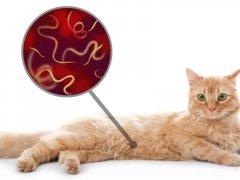
Lymphoma is one of the most common feline cancers, with around a third of new cancer cases being diagnosed as lymphoma each year. But what is it, and is your cat at risk?
What Is Lymphoma?
Lymphoma is a type of cancer. In fact, it is thought to be the most common type of cancer to affect cats worldwide. It’s a cancer of the lymphocytes—a type of immune system white blood cell—and as these cells are so widespread, lymphoma can be found almost anywhere in the body.
What Causes Lymphoma in Cats?
Whilst all cats are at risk of lymphoma, there are a few things that increase a cat’s risk of disease. For instance, older cats are more at risk of lymphoma, with cats around 10-12 years being more likely to be diagnosed than younger cats. Male cats are also slightly more likely to get lymphoma, and unneutered cats, or cats that were neutered late in life, are also more likely to suffer with it.
This is partly because some types of lymphoma are more likely in cats that have been infected with Feline Leukemia Virus (FeLV) and, to a lesser extent, Feline Immunodeficiency Virus (FIV). Other reasons that a cat may be more likely to get lymphoma have been discussed, but none have been proven.
In 2002, a paper suggesting a link between nicotine from smoking and lymphoma was published, but a recent 2020 paper found no link between the two.
Common Sites of Lymphoma in Cats

Lymphomas most commonly develop in the gastrointestinal tract, but they can develop in several sites around the body.
Feline lymphoma can be found in several different sites. Each ‘type’ of lymphoma is named for the area that it is found.
- Alimentary or Intestinal Lymphoma– By far the most common lymphoma in cats, this type of lymphoma affects the guts. Intestinal lymphoma can actually be split into two further types- small cell lymphoma, and large cell lymphoma. Small cell lymphoma is a slow-growing, cancer-causing gut thickening, whilst large cell lymphoma creates hard tumours in your cat’s guts and/or stomach. Large cell lymphoma in cats is far more aggressive and has a poorer prognosis.
- Mediastinal Lymphoma– This type of lymphoma grows in your cat’s chest, usually between their lungs. Over time, it can grow large and put pressure on the lungs and heart. It’s more common in younger cats and those with FeLV.
- Renal Lymphoma– Lymphoma can also affect the kidneys, causing symptoms similar to chronic kidney disease as the kidney cells are replaced by cancer cells.
- Nasal Lymphoma– Nasal lymphoma affects the nose of cats and usually starts as a facial swelling. In about a quarter of cases of nasal lymphoma, the cancer has spread to other parts of the body.
Miscellaneous Lymphoma Types in Cats
There are also less common forms of lymphoma affecting the nerves, the lymph nodes, or other sites in the body. Multi-nodal lymphoma/multicentric lymphoma, cutaneous lymphoma, mesenteric lymphoma, ocular lymphoma, and spinal lymphoma are all other types of lymphoma in cats. There is some evidence that cutaneous lymphoma in cats is becoming more common.
Signs and Symptoms of Lymphoma in Cats
The symptoms of lymphoma in cats vary slightly depending on the site that’s affected, although all types of lymphoma in cats can cause weight loss, lethargy, and a poor, dull, or greasy coat. Cats with lymphoma may have an increased or decreased appetite, or you may notice no change in appetite.
The most common type of lymphoma- gastrointestinal lymphoma- affects the gastrointestinal tract so causes weight loss, diarrhoea, and vomiting.
Changes in drinking and urination habits can be a sign of renal lymphoma, although all lymphomas have the potential to cause an increase in drinking. Neurological signs, such as seizures, head pressing, and blindness can occur with nasal lymphoma and nervous system lymphoma.
A change in respiratory rate, difficulty breathing, coughing, panting, and difficulty exercising can occur with mediastinal lymphoma. And swelling of the nose, discharge from the eyes and nose, and sneezing or nosebleeds can occur with nasal lymphoma.
Other symptoms of lymphoma include:
- Weight loss and poor condition
- Change in thirst, usually increased
- Change in appetite, usually anorexia
- Vomiting and diarrhoea
- Increased urination
- Sneezing
- Coughing
- Increased respiratory rate, effort, or noise
- Nose bleeds and mucus discharge from the nose
- Facial swelling
- Seizures
- Confusion, disorientation
- Blindness
- Depression and lethargy
- Swollen or painful lymph nodes
Because these clinical signs are vague, and can be symptoms of many other diseases, your veterinarian will need to do further testing if they suspect your cat has lymphoma. They will likely start with a complete blood count, as changes in the lymphocytes may be recognised here. Ultrasounds, x-rays and CT-scans can help by allowing your vet to see any abnormalities in more detail.
Your vet will also want to take a biopsy of the affected area- by harvesting a few cells with a fine needle aspirate or a small lump via a surgical biopsy, they should be able to get a diagnosis. The tumour is then ‘graded’ to describe how aggressive it is- low grade lymphoma is less aggressive than high grade.
Treatment Options and Prognosis

It’s important to have your cat tested by a veterinarian to reach a final diagnosis.
Feline lymphoma can be treated with surgery, chemotherapy, or radiotherapy, depending on the type, grade, and location of the cancer. The difficulty with treating lymphoma in cats is that the cancerous cells are generally spread over a large area, so it’s not as simple as just ‘cutting them out’.
Chemotherapy is the most common lymphoma treatment plan in cats, as it can help to kill all cancer cells including those not in the main location of the tumour. Chemotherapy for low-grade lymphoma usually involves tablets, whilst high grade lymphoma is more likely to require injectable chemotherapy.
Cats tolerate chemotherapy very well and don’t suffer too badly with side effects- they rarely lose their hair or appear sick, but some will get mild vomiting or diarrhea. Oral chemotherapy with prednisone and chlorambucil is suitable for small cell lymphoma, but the more aggressive types of lymphoma need a more intense treatment including injectable chemotherapy drugs. This chemotherapy protocol is commonly called a ‘CHOP’ protocol and includes cyclophosphamide, doxorubicin, prednisolone, and vincristine.
We have listed the most common type of therapy pursued and the average survival times below:
- Small cell GI lymphoma: oral chemotherapy. 80% go into remission for 2-3 years
Large cell GI lymphoma: aggressive chemotherapy, 50% with some remission, survival 3-10 months. - Mediastinal lymphoma: aggressive chemotherapy, survival is 3 months if cat has FeLV, 9-12 months if no FeLV.
- Nasal lymphoma: chemotherapy or radiation therapy. 80% respond well, survival up to 2 years.
- Renal lymphoma: aggressive chemotherapy improves symptoms in around 60% patients, but survival is typically 6 months.
Conclusion
Lymphoma is a common and serious cancer in cats. The most common type of lymphoma is gastrointestinal lymphoma, and it’s poorly understood.
However, mediastinal lymphoma and renal lymphoma are both associated with feline leukaemia virus infection, so it’s recommended that you cover your cats with the FeLV vaccination to help prevent lymphoma.







